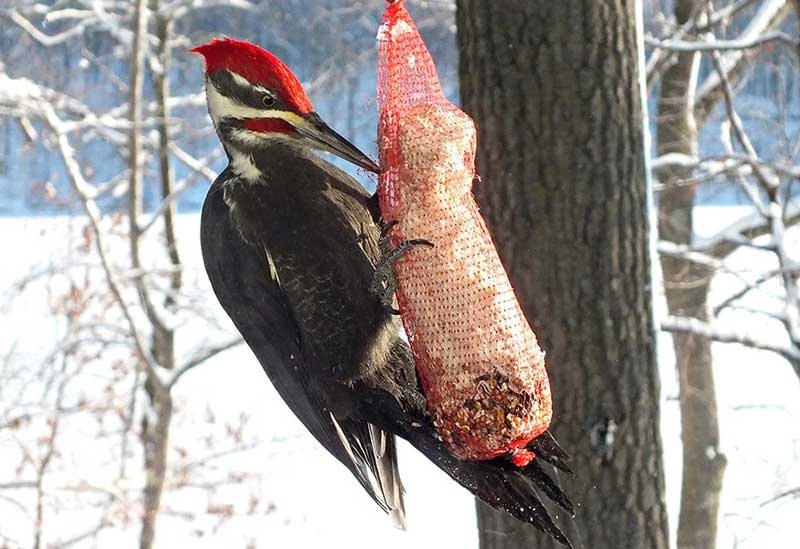RiskVA
Feeding Winter Birds 25 Dec 1997
Although winter in East Texas doesn’t stress birds as severely as the snowy weather to our north, they still have a challenging time finding food during this time of year. Birdfeeders will quickly attract a wide variety of feathered freeloaders intent on eating you into bankruptcy. Goldfinch flocks are particularly voracious and pushy. Other visitors to local feeders may include woodpeckers, cardinals, blue jays, pine siskins, nuthatches, sparrows, purple finches, titmice, chickadees, and juncos.
Food and Protection Are Important
The number and variety of birds that come to your feeder will be governed by the food you provide, and by cover and concealment near the feeder from shrubs and small trees. A great use for your old Christmas tree is to stand it near your feeder as a perching and hiding place. Birds are quite picky about their food. Suet (from the meat market) and peanut butter will attract woodpeckers. Cardinals like sunflower seeds, while goldfinches, nuthatches, and many other small birds thrive on thistle seed. Using a specialized feeder for this will keep the waste down – birds are also messy eaters. A commercial “wild bird mix” will be attractive to a wide variety of birds and isn’t as expensive as thistle seed, but the local bird gourmets don’t seem to like the mix as well as thistle.
If You Start, Don’t Stop!
Once you start feeding, don’t stop until spring. Birds tend to become dependent on the free handouts and they stop looking for other food sources. Tar and molasses may slow down in cold weather, but the little heat factories of bird metabolism do not. Their bodies burn calories at a furious rate and in order to maintain life, they need a continuous supply of food. An indication of the rapid rate of a bird’s life processes are a heartbeat often exceeding 100 beats per minute and a normal body temperature of about 102 degrees. Without adequate food, “burnout” takes on a critical meaning for overwintering birds. If you suddenly cut off their supply, they may not be able to adapt quickly enough to avoid death, especially during very cold weather.
Bird behavior at the feeder is interesting to watch, and it will quickly become apparent that “pecking order” has real meaning for our avian friends as they parry and thrust to establish their status at the banquet table. Also, notice how the feet of small birds allow them to clutch branches and the edges of the feeder. Perching birds have a special leg and foot design that causes their toes to automatically grip when they sit down. Since birds sleep on branches, that arrangement is particularly handy. They land on a branch, scrunch down, get comfortable, fluff up, and go to sleep, their feet securely locked around their docking station. Without this failsafe mechanism, perching birds would be like Snoopy’s friends, forgetting to hold on and having miserable, sleepless nights drowsing and crashing.
Feathers Keep Birds Dry and Warm
A bird’s feathers provide a raincoat, protection from injury, and excellent insulation. The next time you find a feather, look at it closely and notice that it is made up of thin, parallel strands that are fastened together in the feather’s blade. If there are splits in the feather, carefully run a finger over the opening and invisible little hooks will link up again making the feather smoothly continuous and waterproof. Birds use their beak to smooth their feathers to re-hook these little latches when they get roughed up, and also to spread waterproofing oil over the feather surface.
Beneath their surface plumage are specialized down feathers that are vital for insulation. Watch perched birds when it is very cold. Tiny muscles attached to the shafts of their feathers contract, raising them so the down can fluff up, increasing dead air space and slowing heat loss. People have a similar feature, with muscles attached to the base of hairs. Ever notice “goose bumps” on your arm when you are cold? Each bump is a muscle trying to raise the fur coat or feathers you don’t have. For birds it works well, and chilly birds often look like little puffy balls with a beak and eyes, their feet warmly hidden underneath them.
So, this winter, feed the birds and enjoy their antics. Invest in a good bird book such as the Peterson Field Guide Birds of Texas, or the Golden Field Guide Birds of North America, settle yourself in a comfortable chair at a window near your feeder and expand your knowledge and appreciation of some of the most fascinating dwellers of East Texas fields and forests.
Dr. Risk is a professor emeritus in the College of Forestry and Agriculture at Stephen F. Austin State University in Nacogdoches, Texas. Content © Paul H. Risk, Ph.D. All rights reserved, except where otherwise noted. Click paulrisk2@gmail.com to send questions, comments, or request permission for use.



